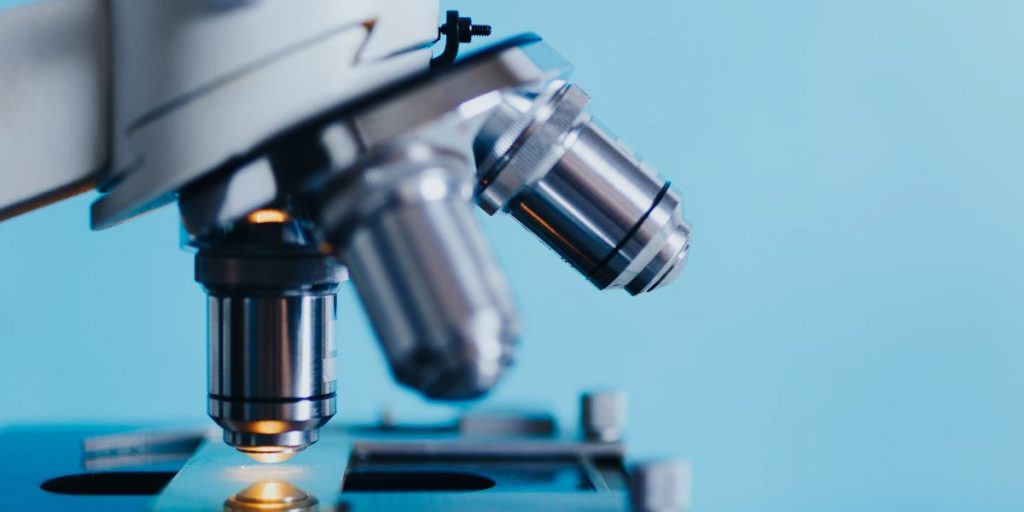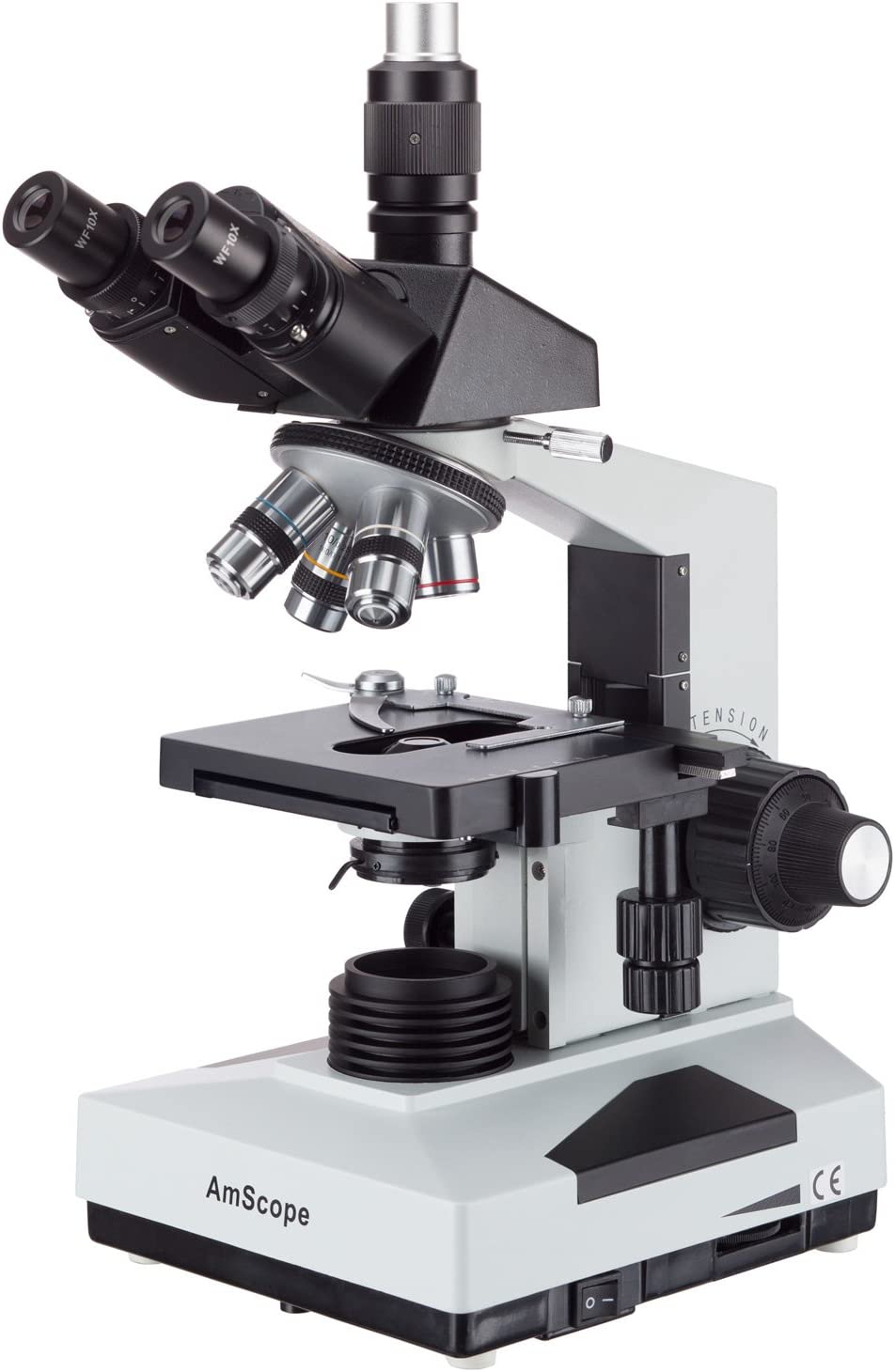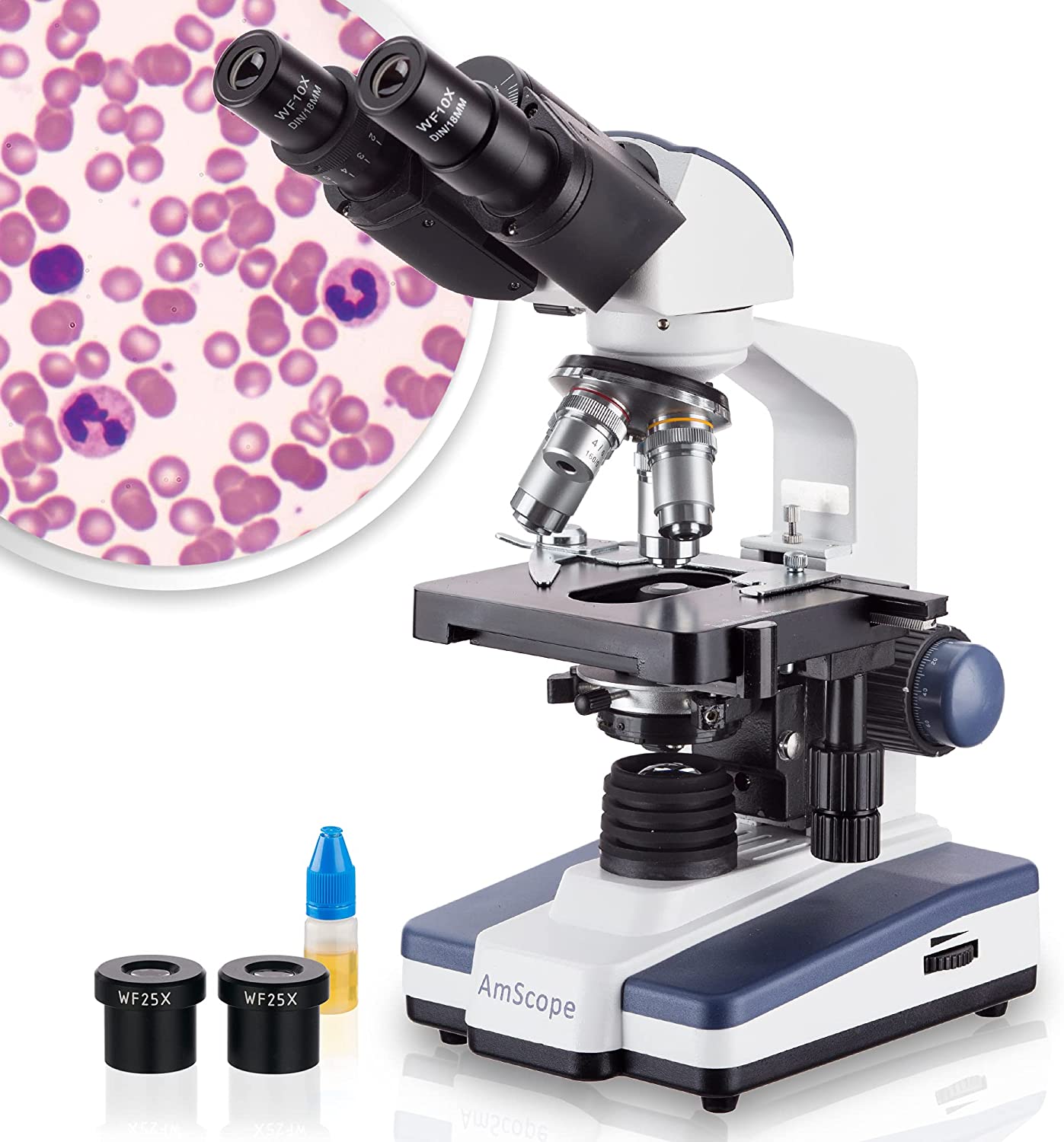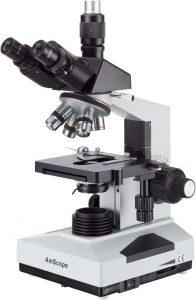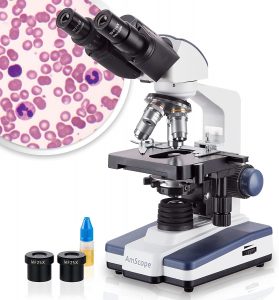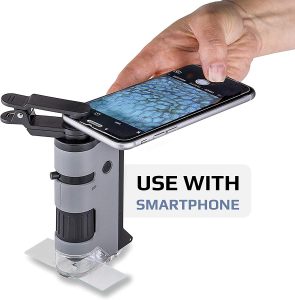Do you need a microscope to study mushrooms? That depends. If what you want to do is learn a little about fungi and put a name to some of the mushrooms you see while out and about hiking, then no, you don’t.
You can probably get away without one to do a little foraging, too, though there will be some species you won’t be able to differentiate.
But if you really want to identify any mushroom you’re curious about to species, then yes, you do need a microscope[i]. Likewise, if you are doing serious mycological research or are curious about the details of the fungal life-cycle, you need a microscope.
You will next want to know what kind of mushroom you should get, what features to look for, even what makes a microscope good. For answers to those questions, read on.
IN A HURRY? HERE'S OUR TOP PICKS...
PRODUCT | Header | |||
|---|---|---|---|---|
OUR #1 RATED | ||||
Types of Microscopes
We’ll start by going over the main types of microscopes[ii]. Although most of these designs aren’t especially good choices for mycology, it’s important to know about them so you don’t get confused when you’re looking at product descriptions.
Every microscope you encounter will fall into one of the following categories—all other variation is a matter of what features and what kind of quality the microscope has.
Simple Microscopes
A simple microscope is basically a tube with a magnifying lens on one end, plus whatever other structures and features support the functioning of the lens (a light source, a stage for setting specimens on, a focus knob, and so on). There is a limit to what a single lens, however good, can do, so you’re not going to be able to do much mycology with one of these devices. They are useful in professionals where extreme magnification isn’t necessary. And even mycologists find simple “pocket microscopes” useful to take into the field—they can’t show you the shape of fungal spores, but they can certainly show you more than what your eyes alone could manage.
Simple microscopes are usually very affordable. Some are extremely so. They are good choices for children or other beginners who want to play around with microscopy and get an introduction to the world of the very small.
Compound Microscopes
A compound microscope has a lens at both ends of its tube. The two lenses have a multiplying effect, so that if one has 10x magnification and the other 40x, you’ll achieve 400x, which is enough to see the shape of spores. Depending on what kinds of lenses you have and what the other features are, you’ll be able to achieve 1000x or better, which is close to the limit of what any light microscope can do according to the laws of physics. Compound microscopes are favorites of serious students and researchers alike in many fields, so they’re widely available. And while some are certainly extremely pricey, it’s possible to find a good one without breaking the bank.
Most of this article will focus (no pun intended) on compound microscopes.
Digital Microscopes
A digital microscope has the same kind of optics as equivalent non-digital options. The difference is that the magnified image gets sent to a digital camera instead of, or in addition to, your eye. The image is then displayed on a screen and can be recorded, either as still shots or as video. It is possible to attach a camera to a non-digital microscope, and some have an extra eyepiece specifically for camera attachment, so It’s not an all-or-nothing situation, but a digital microscope is a good option if your primary use for the device is going to be either photography or as part of some sort of talk or lecture.
Stereo or Dissecting Microscopes
Stereo microscopes, also called dissecting microscopes, are basically two compound microscopes pointed at the same place. That is, not just are there two eye pieces, there are also two objective lenses in use at the same time. Each eye has its own path down to the specimen, meaning you get a 3D image. You don’t actually need a stereo microscope for mycology, but it does help by making otherwise confusing images much easier to make sense of.
Stereo microscopes are somewhat pricier, and there is a bit of a learning curve if you’re used to compound microscopes. They are not quite as popular as other designs.
Electron and Laser Microscopes
Microscopes that work by bending light are limited by the fact that light itself has a size and can’t be used to view anything that is too small. A way to think of this is to imagine trying to deduce the shape of a building by bouncing a basketball off of it. If you could keep track of how quickly the ball bounced off and at what angle, you could eventually figure out where the walls were and so forth. But you couldn’t figure out whether the walls were made of brick or stucco because a basketball is too big for that kind of fine detail to make any difference as to how it bounces. You’d need to switch to something smaller.
To look at things too small for light to reveal, you need something smaller than light. And indeed there are microscopes designed to use streams of electrons or lasers (yes, lasers are made of light. No, we’re not going into detail about how laser microscopes work). These machines are utterly unnecessary for mycology and far to expensive to use to play around with, but they do exist.
IN A HURRY? HERE'S OUR TOP PICKS...
PRODUCT | Header | |||
|---|---|---|---|---|
OUR #1 RATED | ||||
Microscope Features, Basic and Optional
So, you’re going to get a compound microscope. The next question is what features your microscope should have?
There are three that you really must have because without them you will not be able to get clear images at 400x magnification or better—the absolute minimum if you are going to use spore shape to help identify your samples (and to be clear, there are mushroom species that can be identified no other way):
- Rotating nosepiece with three removable objective lenses (4x, 10x, and 40x) and room for a fourth
- Fine focus
- Abbe condenser
There are also three more features you really should get if you can afford them, as they will substantially expand what you can do and how easily you can do it:
- Oil-immersion objective lens (10x)
- Mechanical stage
- Binocular head
Let’s look at why these features are important.
Rotating Nosepiece with Removable Objectives
An “objective” is the lens at the end closest to the specimen. You’ll want at least three: 4x, 10x, and 40x. Since most eye-piece lenses are 10x, that gives you a choice of three magnification levels: 40x, 100x, and 400x. Getting higher than that is why you need a space for a fourth objective. You’ll want DIN lenses, as this is an international standard, meaning you’ll always be able to get replacement lenses even if your manufacturer discontinues a model.
“Nosepiece” is a strange word, since it refers to the microscope’s nose, not yours. That is, if the objectives are the microscope’s eyes, then its nose is the part between the eyes. Of course, the eye-piece is the piece near your eyes, not the microscope’s. Traditional terminology doesn’t always make sense. In any case, a rotating nosepiece is a plate to which multiple objectives attach so that you can rotate a new objective into position for a closer look.
There are low-power microscopes of decent quality that don’t have rotating nosepieces, but for high magnification you need more than one objective.
Fine-Focus
All microscopes have a coarse-focus knob. Some also have a fine-focus knob. Without a fine-focus knob, your most powerful lenses are more or less useless. That’s because focusing a microscope involves changing the distance between the end of the microscope and the thing you are looking at, and the high the magnification, the closer the microscope has to be to your specimen. Without fine-focus, if you try to get above 400x, you will almost inevitably move the microscope too far, bump into your slide, and crush it.
Some slides are irreplaceable. At the very least, destroying your specimen instead of looking at it would be a pain.
The proper procedure is to use the lower-powered objectives while adjusting the coarse-focus, then switch to fine-focus for the higher-powered lens.
Abbe Condenser
A condenser is a device that gathers light and focuses it on your specimen. The Abbe condenser is a type invented by a man named Ernst Abbe. Not all microscopes have condensers—not all of them have their own light source. Some very basic models have only a mirror that directs whatever light you have in the room, an arrangement that saves substantially on cost. Unfortunately, the higher magnification you use, the more light you need, so a microscope without its own light source and a good condenser has trouble getting to 300x no matter what lenses it has because the image will get too dark.
Oil-Immersion Objective Lens 100x
This is the fourth objective you need room for in that rotating nosepiece. Without it, you can still use your microscope for mushroom identification—you can see the size and shape of spores—but if you want to be able to see basidia or other such structures for yourself, you’ll need at least 1000x. That’s what a 100x objective gives you.
These are expensive, and you might not be in a position to spring for one when you first get your microscope, but you’ll definitely want to option to add one later.
Mechanical Stage
The stage is the platform on which your specimen sits. A mechanical stage can move smoothly and precisely so that you don’t have to move the slide itself to look at a different spot. And because the movement of the stage is precise, you can return it to where it was before—without it, you will probably never be able to find the same thing twice.
Binocular Head
A binocular head is simply a double eye-piece. If you don’t have a stereo microscope, your image will still be two-dimensional, but if you’ll be using your microscope very often, being able to use both your eyes at once is definitely more comfortable.
Other Considerations
There are many other features your microscope can have, depending on what your budget is and what you want to use your microscope for. Most of them are essentially optional, so you can learn about them yourself as you get deeper into microscopy. But there are a few details to watch out for because they tell you whether or not a microscope is a toy.
There is nothing wrong with a toy microscope because there is nothing wrong with playing—even adults can learn a lot about microscopy by playing around with inexpensive and basic equipment to see what it can do. And as mentioned earlier, there are circumstances where a very basic microscope can actually be a very practical piece of equipment. But toys should be priced as such, and should be marketed in a way that is honest about their capabilities. Sadly, that’s not always what happens.
Glass Optics
If the price is about $50 or so, you should expect your microscope to have have glass optics and reasonably good alignment of the lens system. The more you pay, the better the alignment should be. Metallized plastic is much cheaper to make and can perform decently at lower magnification, say 100x or 200x—and some of these models are quite decent for what they are. But any microscope without glass optics that is priced above the toy range or supposedly has magnification is more or less part of a scam.
A cheap plastic microscope with 600x or 700x is a straight-up lie, as it is physically impossible for even the best glass optics to get above the 400x to 500x range without an oil-immersion lens—and those lenses alone start at $100. Even 400x is out of the reach of most toys, even if their lenses do provide that much magnification. The problem is that without good enough alignment or a quality condenser, you won’t be able to see much of anything.
Parfocality
A parfocal microscope maintains its coarse focus when you change objective lenses. This way, you can adjust the coarse focus at 100x (with the 10x objective), and then switch to the 40x or 100x objective and adjust the fine focus. If you had to adjust the coarse focus at 400x, you’d probably crush your slide, as mentioned earlier—especially if you were a beginner.
Again, any microscope sold for $100 or more should have this feature, but, more importantly, any microscope that has a 40x objective should, otherwise slides will get crushed and objective lenses could get damaged.
Parcentricity
A parcentric microscope allows you to change objective lenses (by rotating the nosepiece) without having to re-center the specimen in your field of view. Without this, good luck finding the little creature again. Any microscope sold for $100 or more should be parcentric. Without it, you’ve got a toy.
Best Microscope for Mushrooms
“The best” is always a judgment call—your mileage may vary, as they say—but these are some interesting and well-regarded microscopes. Note that both of the two compound microscopes[iii] in the list have all of the features we advise looking for, we just elected not to repeat all of that in the product descriptions.
Best Microscope Overall: AmScope T490B
The T490B is not the world’s most expensive compound microscope. In fact, it’s quite affordable, and its ease of use makes it a good option even for beginners (though it is a precision instrument and needs to be respected accordingly). But, at the same time, it has the quality, and even all the bells and whistles a serious mycologist could want. You could pay a lot more, but you’ll only get a little more function. This microscope is an excellent deal.
The T490B is a trinocular microscope, meaning it has three eye-pieces. The third one is for a camera attachment (not included). And unlike with many trinocular devices, the third eyepiece looks at exactly the same spot as the other two, so that you can take stills or video of exactly what you’re working on without re-focusing. The quality of the optics is very impressive. An oil immersion objective is included, and there are plenty of other objectives and condenses you can buy separately if you want to upgrade your microscope further.
The model comes with either a halogen light or, for those who need to keep their specimens cool, an LED light. Make sure to get the right one for your needs.
One issue is that an oddly high number of customers report mechanical glitches, components not working right or otherwise having issues. However, the company is usually very good about diagnosing the problem and replacing the relevant part.
Best Bang for Your Buck: AmScope B120C
The B120C series has nearly all the same features and quality as the T490B, but lacks the third eyepiece—and is therefore substantially more affordable. While photography is important to many users, it’s not really necessary for most of them—and it’s still possible to attach a camera to a binocular microscope, it’s just not as convenient.
Customers who complain about poor quality appear to have gotten used microscopes while expecting new, possibly due to a problem with the vendor they bought the microscopes through. It’s an issue to be aware of while shopping, but it appears not to be a design flaw.
This series includes several versions, giving you a choice of maximum magnification. While a microscope with 2000x or 2500x sounds cool, that’s far more magnification than you really need for mycology. The B120A, with a maximum magnification of 1600x is probably your best bet, especially if that means a lower price point.
Best Pocket Microscope: Carson MicroFlip
A pocket microscope will not let you see the size and shape of spores. None have quite enough magnification, and thus none can replace a compound microscope. But a good-quality compound microscope can’t fit in your pocket when you go hiking, either. Pocket microscopes are good for figuring out what’s worth taking home for a better look. They are also good for examining things that you can’t take home at all. And since this model can go up to 250x, far better than most other pocket microscopes, it can give you a lot of information that you wouldn’t otherwise have while still in the field.
There is a clear base that can be used as a stage to hold slides, or you can flip that out of the way and just press the device up against something large and flat you want a good look at. There’s also a clip you can use to attach the eyepiece to the camera of a smartphone, a useful touch. Quality, while not what you’d expect from a professional-type compound microscope, is really quite good for what it is.
Most customers who left bad reviews were actually complaining that the magnification is too powerful.


